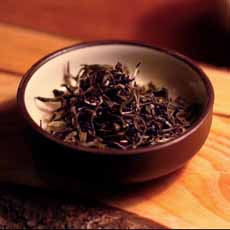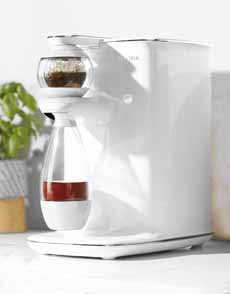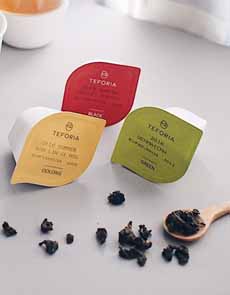PRODUCT: Teforia, A Revolution In Tea Making…& The History Of Tea Bags
|
Man has been brewing tea for thousands of years—using loose leaves (photo #1) until the accidental invention of the tea bag in 1904. A BRIEF HISTORY OF THE TEA BAG Ships bearing tea from China first arrived in Britain in the 17th century, and their cargo created a drinking passion among Britons. The first teas to arrive were green teas (photo #2), but by the late 18th century, black tea overtook green tea in popularity. It was discovered that milk and black tea—with a lump of sugar—were a perfect pairing. In the 19th century widespread cultivation of tea had begun in India, a British colony, and overtook the import of Chinese tea to the U.K. At that time, all the tea in the world a was prepared as loose tea, necessitating mesh tea balls, tea eggs—perforated metal containers to hold tea leaves—and other strainers to keep the leaves of the brewed tea out of the cup. A radical change occurred at the beginning of the 20th century, with the accidental invention of the tea bag. It offered at least four benefits: In 1904 or 1908—or perhaps earlier*—Thomas Sullivan, a New York tea merchant, switched from sending tea samples to his customers in the customary metal tins, to far-less-expensive silken bags. Some clients assumed that the bags were supposed to be used in the same way as the metal infusers, and placed them into pots of hot water. It was accidental birth of the tea bag. Responding to the customer comments that the mesh on the silk was too fine, Sullivan switched to gauze and created the first purposefully made tea bags. In the 1920s tea bags were widely available commercially, and the grew as the preferred brewing method in the U.S. They were available in two sizes: a large bag for the pot and a small bag for individual cups. A string was attached (photo #3) so the bag could be easily removed. Fabric bags evolved into the less-expensive paper bags. By the way, the Brits took far longer to embrace tea bags. Here’s the scoop. The next leap came in with individual pod/cup coffee machines, which offered options for tea. In order to work in the machine, the tea leaves had to be ground as finely as coffee. This instant-brewing did not produce quality results: Tea leaves need to be brewed for several minutes. contained tea, ground for instant-brewing. Manufacturers came up with appliances dedicated to brewing tea (but not a lot of them). Seven years ago we bought one of them, the Breville One Touch Tea Maker, happily for a year until the carafe cracked. Turns out there was no replacement carafe. The solution was to buy a new machine for $250, and toss the electric base into the landfill. As the carafe had cracked due to what we believed to be a manufacturing problem (we never knocked it), we declined. Why the lag in tea-brewing appliances vis-a-vis all the options for coffee? The U.S. and much of Western Europe are coffee-drinking countries†. While interest in artisan tea has exploded over the past 20 years, the volume† still pales next to coffee. This year saw the debut of second edition of Teforia, a high-tech tea infuser that, like the Breville One-Touch, uses algorithms based on appropriate brewing times to craft the richest and most flavorful cups of tea possible. The first edition, Teforia Classic, debuted in 2015 at the price of $999. In Silicon Valley, where it was born, that may not be much for an appliance that will sit in a $250,000 kitchen. But it was out of touch for most of us; hence the Teforia Leaf, for a more affordable $399 at launch, and comparable to mid-range coffee machines. The price is lower by making the smart technology simpler. “Simple” means a dual-core, dual-threaded Intel Atom CPU, a 32-bit Intel Quark microcontroller, 1GB ram and WiFi connectivity. And unlike the Breville, the replacement carafe is affordable. |
|
|
|
Much more sophisticated than the Breville, Teforia’s algorithms have precise settings for: Has any Chinese emperor, or modern billionaire, ever had a better-prepared cup of tea? *Details vary by source, but per Wikipedia, tea bag patents date as early as 1903. They first appearing commercially around 1904, and were successfully marketed about 1908 by the tea and coffee importer Thomas Sullivan of New York, who shipped his silk tea bags around the world. †Based on data compiled by Euromonitor International, tea still outsells coffee in populous countries like China and India, as well as the U.K., Russia, Ireland, Chile, Morocco, Turkey, South Africa and Egypt. Here’s a graph on worldwide consumption of tea versus coffee. |
||
|
[6] Our conclusion: Teforia is an item for the wealthy, who want “the best” and don’t mind if, at some point, they can no longer use the appliance (photo courtesy Teforia). |
WHAT KIND OF TEA CAN YOU BREW?
Where does the tea come from? Aye, there’s the rub. We can’t imagine why the company removed the option to infuse your own tea. It limits both the options (there is no decaf, for example). The tea is brewed with “Sips,” individual portion capsules that contain what the company maintains is the highest-quality loose leaf tea on the planet. Five of the teas can be brewed with either standard or boosted caffeine levels, with just the touch of a button. The tea is correspondingly pricey. The tea is brewed into a carafe that holds six ounces: the small-size cup that comes with a formal set of china. A mug can hold double that. For a classic Chinese or Japanese tea set, which has tiny cups, a carafe may fill four cups. You can make a carafe of “Daybreak Black” tea or Masala Chai for $1, but better teas go up in price. For example: But the selection of teas is small. If you want Assam or Jasmine, for example, you’re out of luck. And if the company stops producing any or all of the Sips varieties, you’re out of luck. The Teforia exists, because, per the company, “Tea is vastly complex, and each varietal requires a different process to brew the perfect cup. Water temperature, steeping time, ratio of tea leaves to water, and number of infusions are all unique variables in the brewing process.” Scientifically, this is so; but tea has been cultivated since 1000 B.C.E. or earlier, and many people have enjoyed a well-brewed cup of tea made by hand. |
|
|
At the finest tea parlors in the world, the modern cup of tea is hand-brewed with a tea thermometer and a watch. Now that science has determined exact brewing temperatures and durations, hand-brewing at x degrees for y minutes does the trick. That technology now does this—and adds some bells and whistles, like brewing time algorithms the ability to add another jolt of caffeine—is certainly of interest. But not at the price, except for a small niche market. And if you add milk and sugar to your tea, you are likely to discern no difference whatsoever [assuming you are brewing the same tea leaves]. The Teforia Classic won the 2017 World Tea Award for Best Tea Brewing Device, but it is now sold out on the company website. Will it return? Perhaps a professional tea taster will taste the difference, but will you? Even if they gave the Teforia away—the razor blade model, where the razor may be inexpensive but the proprietary blades generate a lifetime income stream—the price to brew each cup of tea remains high. But more seriously: This is a new product. Who knows how long it will continue to be produced, and how long sips will remain available? As of today, the item is “sold out” at its key outlets: Nordstrom, Williams-Sonoma, and the Teforia website itself. Personally, we really enjoyed the Breville, and if we could get over the fact that the carafe cracked too soon into our ownership (with no warranty), we’d get another one.
|
||








